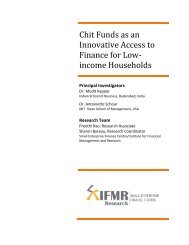Government of India Volume I: Analysis and Recommendations
Government of India Volume I: Analysis and Recommendations
Government of India Volume I: Analysis and Recommendations
You also want an ePaper? Increase the reach of your titles
YUMPU automatically turns print PDFs into web optimized ePapers that Google loves.
FUNCTIONS AND POWERS OF THE REGULATOR<br />
The Commission recommends that depending on the cause <strong>of</strong> the violation the regulator<br />
must apply the following consequences in increasing order:<br />
1. Issuing a private warning;<br />
2. Issue a public notice;<br />
3. Require a corrective action applicable to the violation;<br />
4. Impose a monetary penalty;<br />
5. Suspend the permission to carry out certain transactions;<br />
6. Permanently revoke the permission to carry out regulated activities; <strong>and</strong>/or<br />
7. Institute criminal proceedings in appropriate courts.<br />
4.2.6. Imposition <strong>of</strong> monetary penalties<br />
The Commission noted that the present system <strong>of</strong> specifying statutory limits on the amount<br />
<strong>of</strong> penalties that can be imposed for any violation has a critical flaw – it does not<br />
ensure that a violator pays a fine higher than the gain made through the violation. This<br />
is because it is impossible to predict the benefit a violator will gain by committing an<br />
<strong>of</strong>fence. The maximum limit on penalties is sometimes lower than the benefit gained by<br />
the violator through violation. This leads to a situation where even if the violator is caught<br />
<strong>and</strong> required to pay the fine, he or she may still emerge monetarily better <strong>of</strong>f.<br />
The Commission notes that the level <strong>of</strong> penalties should be an effective deterrent to<br />
future violations <strong>and</strong> signal all other regulated entities that the potential <strong>of</strong> gain from violation<br />
will be outweighed by the penalty which will be applied in the case <strong>of</strong> detection<br />
<strong>of</strong> the violation. This principle also acknowledges that all violators <strong>of</strong> any law are never<br />
detected. Therefore, to act as a deterrence, the penalty should be a multiple <strong>of</strong> the illegitimate<br />
gain from the violation. The amount <strong>of</strong> penalty should also be dependent on<br />
whether the action was deliberately done or due to reckless behaviour or due to negligence<br />
<strong>of</strong> the person.<br />
The system <strong>of</strong> imposing financial penalties should be guided by the following principles:<br />
1. The penalty system should require the violator to pay a multiple <strong>of</strong> the illegitimate gain made<br />
from the violation;<br />
2. Out <strong>of</strong> the penalty collected, the regulator should try to compensate any directly identifiable victims<br />
<strong>of</strong> the violations;<br />
3. Any surplus at this point should be deposited with the Consolidated Fund <strong>of</strong> <strong>India</strong>;<br />
4. In the event that there are no direct victims, the regulator must transfer all the penalty (after deducting<br />
administration costs) to the Consolidated Fund <strong>of</strong> <strong>India</strong>;<br />
5. If there is no clearly identifiable illegal gain from the violation, the regulator must impose a<br />
penalty that is a proportion <strong>of</strong> the income <strong>of</strong> the violator from financial activities; <strong>and</strong><br />
6. All systems <strong>of</strong> monetary penalties must be regulated by regulations that consider the magnitude<br />
<strong>of</strong> the violations <strong>and</strong> the previous violations <strong>of</strong> the violator.<br />
The doctrine <strong>of</strong> unjust enrichment allows the regulator to recover all the pr<strong>of</strong>it the<br />
violator made from the violation. Unjust enrichment should be recovered, in addition to<br />
the fine applied for violation <strong>of</strong> regulations. This should be recovered <strong>and</strong> then, if possible,<br />
distributed amongst persons who were adversely affected on account <strong>of</strong> the violation.<br />
Punitive damages create a deterrence for future violators who will know that in the<br />
event that they are successfully prosecuted the penalty they will face will surely outweigh<br />
the pr<strong>of</strong>its that they make. It requires the regulator to expressly impose fines which are<br />
higher than the benefit gained out <strong>of</strong> the violation. This is usually carried out by providing<br />
penalties as a multiple <strong>of</strong> the amount <strong>of</strong> gain by the violator. The Commission found<br />
that this principle has already been provided in some <strong>India</strong>n legislations <strong>and</strong> should be<br />
extended to the financial sector as a whole.<br />
Table 4.11 summarises the recommendations <strong>of</strong> the Commission for creating a legal<br />
system governing penalties.<br />
36 FINANCIAL SECTOR LEGISLATIVE REFORMS COMMISSION



